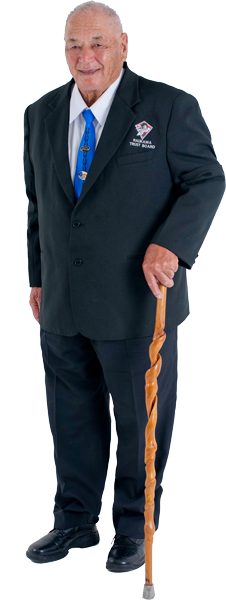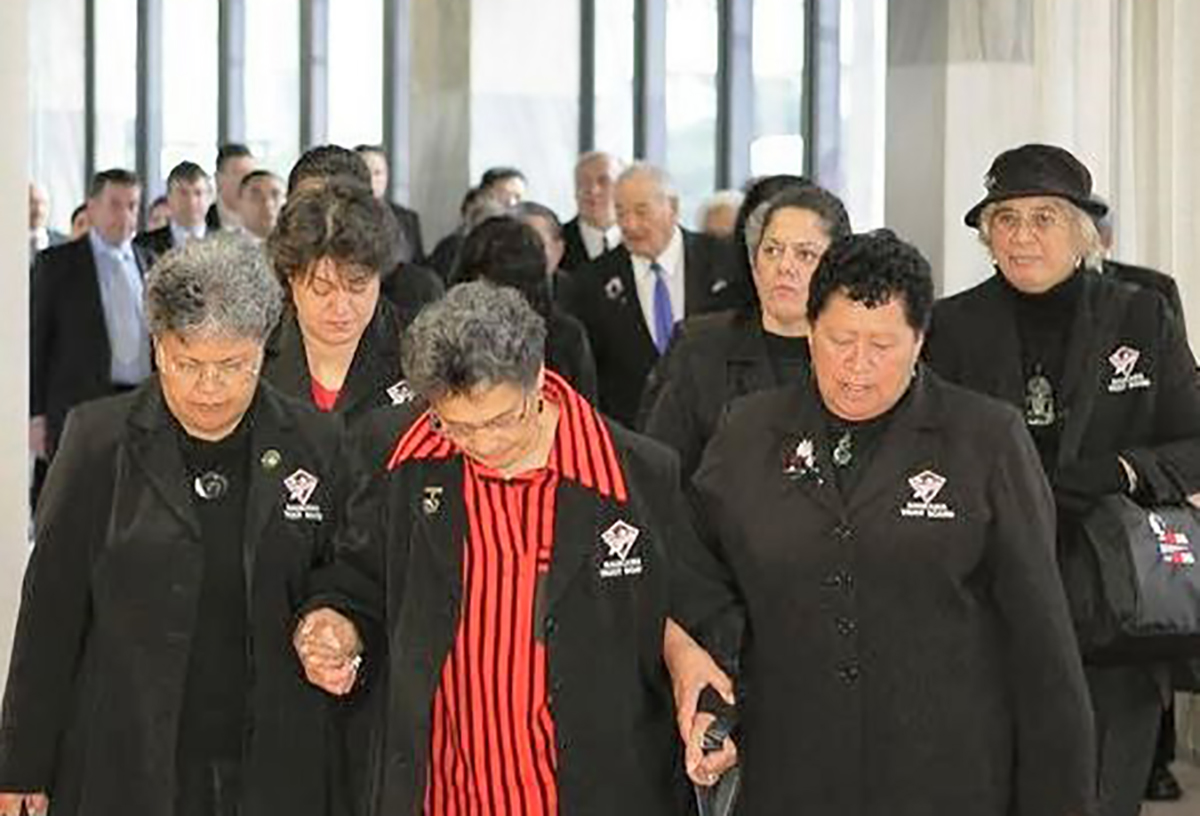The Raukawa Treaty Settlement is comprised of two components
Central North Island Forest Settlement
In addition there was also a separate agreement reached in respect of a Deed in Relation to the Co-Management Framework for the Waikato River 2010 (the River Deed)
Raukawa Historical Treaty Claims Settlement
The second component to the Raukawa settlement was the comprehensive deed.
In Addition, a separate agreement was reached
In 2008, Raukawa joined with seven other Central North Island (CNI) Iwi to sign the Central North Island Forest Settlement

Hori Deane, Koroua of Raukawa

Raukawa members entering Parliament for CNI Signing
In 2008, Raukawa joined with seven other Central North Island (CNI) Iwi to sign the Central North Island Forest Settlement
For Raukawa the CNI settlement reflected the population and interests of Raukawa in the claim area. This meant that Raukawa would receive via the settlement:
- On-account agreed proportion of the accumulated rentals of 14.2125% (this was reduced from 15% reflecting Raukawa’s support for smaller iwi)
- Annual land rental income for 35 years;
- Return of lands via an agreed process;
- Allocation of New Zealand Carbon Credits;
- Rights of First Refusal, Deferred Selection and other Crown mechanisms;
- Priority for CNI Iwi to settle individual comprehensive claims
- The CNI settlement was signed at Parliament on the 25 June 2008.
The second component to the Raukawa settlement was the comprehensive deed.
This deed settled most of the remaining outstanding Raukawa historical claims. Initially led by Chris McKenzie, who resigned in 2012 and was replaced by Vanessa Eparaima as the lead negotiator. Eparaima was ably assisted by her co-negotiators Nigel Te Hiko and George Rangitutia, who passed away shortly after the signing of the Deed of Settlement in 2012.
Although the comprehensive settlement looked to settle all outstanding claims, there were some issues that could not be finalised. Raukawa and the Crown agreed to park these outstanding matters as other iwi were involved and their respective settlements were in an early stage of negotiations or were working towards negotiations.
At a quick glance, the Raukawa comprehensive settlement comprised:
- Historical Account, Crown Acknowledgments and a Crown Apology;
- Cultural Redress
- Financial and Commercial Redress – The Comprehensive settlement was signed at Aotearoa marae on the 2 June 2012.
Deed in Relation to a Co-Management Framework for the Waikato River
Separate to the Comprehensive Settlement negotiations and the CNI was an agreement between the Crown and Raukawa in respect of a Deed in Relation to a Co-Management Framework for the Waikato River (Waikato River Co-Management).
The Deed was signed on the 17 December 2009 at Whakamaru
The Deed included
- An historical account of Raukawa associations to the Waikato River and Crown acknowledgements;
- Partnership between Raukawa, the Crown and other river iwi to co-design a Co-Management framework that focuses upon restoring and protecting the health and wellbeing of the Waikato River;
- Capacity building fund with ongoing capacity funding for 20 years.
- Waikato River Co-Management.
What the Raukawa Settlement is and is not.
During the course of the Treaty settlement process, Raukawa had to change the paradigm within the wider South Waikato community about what the Raukawa Treaty settlement was and what it was not. Certainly, amongst some sectors of the community there were a divergence of views.
In dispelling these myths in 2013, the Raukawa Settlement Trust undertook a series of presentations with stakeholders to explain the Raukawa Treaty settlement.
The Raukawa Treaty settlement is:
- An acknowledgement to rectify historical wrongs committed by the Crown against Raukawa (i.e. acts or omissions that took place before 1992);
- An opportunity for the Crown to recognise the mana of Raukawa, a reconciliation between the Crown and Raukawa;
- An opportunity for Raukawa to achieve its social, cultural, economic and environmental aspirations;
- An opportunity for Raukawa to develop and grow.
- A settlement based upon core principles that sought to honour our tūpuna, to inform our present, to set the platform for prosperity for future generations of Raukawa;
- The opportunity for Raukawa to walk our own pathway;
- The chance to learn about ourselves, our history, our identity, our beliefs and principles;
- A one off, limited resource that must be carefully nurtured and grown.
The Treaty settlement is NOT:
- A multimillion-dollar handout that created a burden upon the taxpayer;
- A panacea for all of the ills within the South Waikato;
- The opportunity for the Crown to abdicate its responsibility to Raukawa and the wider community;
- To substitute Raukawa for the Crown;
- For all Māori living within the Raukawa takiwā;
- A ‘magic hangi pit’ that provided unlimited resources to the community.
The Treaty settlement also gave Raukawa the opportunity to invest directly in the wellbeing of the iwi. From the settlement came marae and kaumātua wellbeing grants, education and sports grants. Although the grants are exclusively for Raukawa uri, all of the other social, cultural and environmental services provided by the Raukawa Charitable Trust are available to all communities within the Raukawa takiwā.
My koroua would say, “with each success, comes greater expectation for more.” This was the situation that Raukawa found ourselves in. Throughout the settlement process, we identified and implemented, a support system to assist our own uri members in their understanding and decision making of what our settlement is and what it is not. Secondly, that support system was offered within the wider community who also held varied views about our settlement.
Kī mai ai taku koroua ki a au. “I ia tutukinga kaupapa, ka nui noa ake ngā hiahia o te iwi kia pērā atu anō.” Koia nei te āhuatanga ki a Raukawa. I roto tonu i ngā whakaritenga whakatau kerēme, i kitea, ā, i whakaritea hoki tētehi tukanga tautoko hei āwhina i ngā uri me ō rātou mōhiotanga, mōhiotanga kore rānei mō ngā whiriwhiringa e pā ana ki tā mātou whakataunga kerēme. Ka rua, ko taua tukanga tautoko i āwhina hoki i te hapori whānui i a rātou anō ngā whakaaro rerekē ki tā mātou whakataunga kerēme.
Prior to receiving assets and redress from the settlement the Raukawa Treaty team was very small. But as we delved deeper into researching the history of the iwi, the call went out to our people for help to grow our capacity and the response was amazing. Up to 70 whānau members heeded the call and voluntarily came in to help with the Native Land Court transcription project. There is a saying “Ahakoa he iti, he pounamu”. No matter how big or how small their contribution was to the project, it helped us to achieve our amazing outcomes. So some whānau members worked with us for a day, others stayed on for months constantly trolling through the minute books for references to the iwi, to our whenua and to our tūpuna who either gave evidence or were mentioned in evidence. The result of this project was the transcribing of literally, thousands upon thousands of pages of Native Land Court minutes. The production of those transcripts went on to form the basis of 16 comprehensive research reports about the iwi and Crown engagement that described significant breaches of the Treaty by the Crown.
I mua i te whakawhiwhinga i ngā rawa me ngā whakatikahanga i ahu mai i te whakataunga, he papaku noa te tīma Tiriti o Raukawa. Engari i te rukuhanga hōhonu ki ngā rangahau i te hītōria o te iwi, rere ai te karanga ki tō mātou iwi hei āwhina mai ki te whakatupu i tō mātou āheinga, ā, i tino pai te whakahoki. Ko tōna 70 tāngata o ngā whānau i tae mai hei tūao ki te āwhina i te kaupapa tauwhaituhi o Te Kōti Whenua Taketake. Arā te kōrero “ahakoa he iti, he pounamu.” Ahakoa nui, iti rānei tō rātou āwhinatanga ki te kaupapa, he āwhinatanga tērā i kōkiri tonu i te kaupapa ki tōna tutukihanga me ōna putanga whaihua. Ko ētehi o ngā mema o ngā whānau i whai wāhi mai ki te mahi mō te rā kotahi, me ētehi atu anō i noho mai mō ngā marama e pānui haere ana i ngā pukapuka mīniti e rapu ana i ngā honohononga ki te iwi, ki ō mātou whenua me ō mātou tūpuna nā rātou anō ērā kōrero i kōrero, i kōrerohia rānei rātou i ngā kōrero taunaki. Ko te hua i puta mai i te kaupapa, ko te tuhinga o ngā manomano whārangi o ngā mīniti o Te Kōti Whenua Taketake. Ka noho ko ēnei tuhinga kōrero hei tūāpapa mō ngā pūrongo rangahau whānui 16 e pā ana ki te iwi me te whai wāhitanga o te karauna, e whakaatu ana i ngā tino takahitanga o te Tiriti a te Karauna.
As a team, it was our responsibility to make sure that all our uri members were informed and updated at each stage of our negotiations whilst working towards our settlement. By doing this our people made their best informed decisions. Amongst some of our uri members there were questions posed like “What was in this settlement for me and how will I benefit?” With questions like these we often referred to the wisdom of our kaumātua, Hori Deane, Jimmy Clair, Toiamoko Manaia, Haki Thompson, Mac Winika, Huirama Te Hiko, Lorna Pope, Kahu Te Hiko, Ruthana Begbie and many others.
Ko tētehi haepapa ki a mātou, ko te āta whakamōhio i ngā uri i ngā taumata rerekē o ā mātou kōrero whakawhitiwhiti nō mātou e kōkiri ana i te whakataunga. Nā konā i i tau ai te wāhanga ki ngā whakataunga tika a te iwi. I ahu mai ngā pātai pēnei i waenga i ētehi o ngā uri, “He aha ngā painga mōku kei tēnei whakatau, ā, he aha hoki ka hua mai ki a au?” I te rongotanga o ēnei momo pātai ka tere huri atu mātou ki te hunga ihumanea, ki ō mātou kaumātua ki a Hori Deane rātou ko Jimmy Clair, ko Toiamoko Manaia, ko Haki Thompson, ko Mac Winika, ko Huirama Te Hiko, ko Lorna Pope, ko Kahu Te Hiko, ko Ruthana Begbie me te maha noa atu.
Their response was simple and clear. They said that we were all one whānau, one people and that no matter where we lived in the takiwā, we all would share equally in the settlement. It was from this that the team drew upon the notion that “no Raukawa uri will receive any more or less from the Treaty settlement than any other Raukawa uri member”. This was a view that we normalised amongst the iwi during our mandating and ratification phases of the process and it was how we managed to hold all our redress assets together in a holistic way, to create a commonwealth for the iwi.
He ngāwari, he mārama hoki tā rātou whakautu. I kī mai rātou, he whānau kotahi tātou, he iwi kotahi, ā, ahakoa kei tēwhea wāhi o te takiwā tātou e noho ana, ka noho taurite te whakataunga ki te katoa. Nā konei, whai haere ai te tīma kia pēnei “E kore tētehi uri e riro i a ia tētehi painga nui atu, iti iho rānei i tētehi atu uri o Raukawa i te whakataunga kerēme.” I horapa haere nei tēnei aronga huri noa i te iwi i ngā wāhanga whakamana i te tukanga, ā, koirā te take i purutia ai e mātou ngā rawa whakahoki katoa hei rawa katoa mā te iwi.